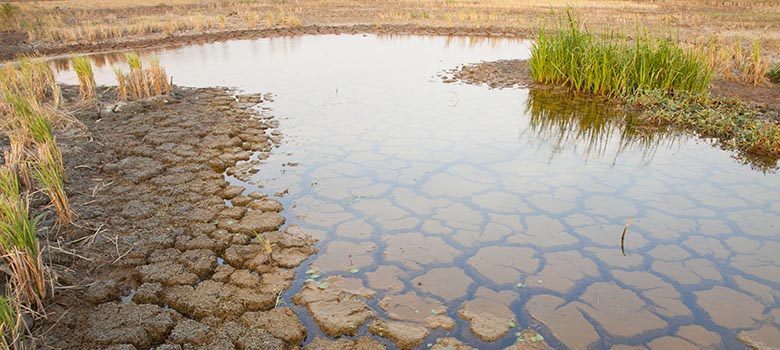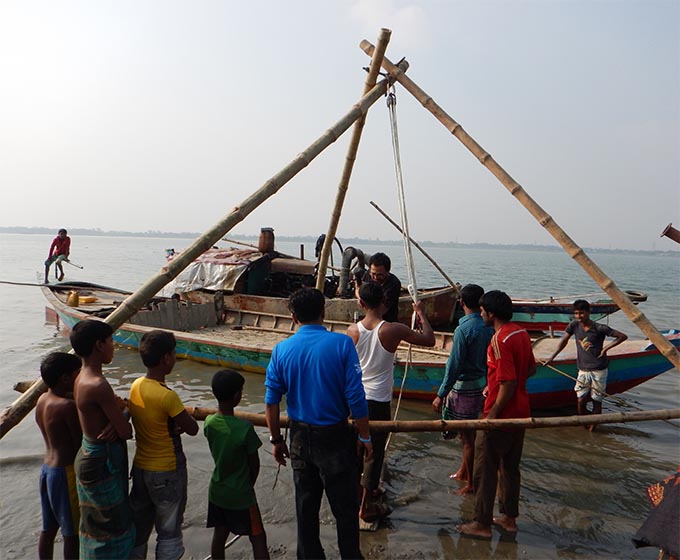
Nov. 1, 2019 – A researcher at UTSA is involved in novel projects to better understand how different nutrients, metals, and metalloids are transferred in our groundwater, surface waters, soils and sediments and the impact that has on human health and the environment.
Arsenic in drinking water is a global health risk that is being examined in-depth by Saugata Datta, the Dr. Weldon W. Hammond, Jr. Endowed Distinguished Professor in Hydrogeology.
Professor Datta is a world-renowned hydrogeologist who is currently researching the movement of arsenic between aquifers and tidally influenced rivers along their interactive boundaries that are affected by heavy sediment deposition across major rivers of the world.
Datta explained that under certain conditions, some rocks and sediments naturally contain enough arsenic to contaminate groundwater and arsenic is one of the most common, naturally occurring carcinogen found in the environment. He added that long-term human consumption of groundwater with elevated concentrations of arsenic is known to cause increased risk of cancer along with reported cases of higher rate of infant mortality and reduced intellectual and motor function in children.
This project aims to understand the conditions under which arsenic is trapped or released in riverbank sediments.
“Groundwater that has lots of iron and arsenic carries huge amounts of these elements to the riverbank sediments. It is important to understand the fate of this trapped arsenic and iron that co-exist. There is a close spatial association between arsenic and iron oxide minerals, a source of arsenic in naturally occurring aquifer sediments, and the co-occurrence between dissolved arsenic and iron in the groundwater and river waters are very important. The goal of this study is to develop a theory on the growth and fate of these iron-arsenic deposits,” said Datta.

Professor Datta involved in sediment coring on the banks of River Meghna, Bangladesh.
Datta, his graduate students, and postdoctoral scholars from UTSA will observe which minerals the arsenic is bound to within sediments on the edge of the Meghna River in Bangladesh. They will translate this work to major rivers of Texas with similar layouts.
Professor Datta has been studying groundwater problems in Texas, Kansas and neighboring states and will expand upon his research with the support of a nearly $300,000 grant from the National Science Foundation (NSF) to work on this 3-year project. He is collaborating with Texas A&M University and the University of Texas at Austin.
In addition to his work on studying groundwater, Datta is a co-principal investigator on a project to work with graphene-based technology to develop an inexpensive phosphate sensor and sensor network capable of real-time monitoring of the phosphorous content in soil from different climatic regimes. Datta said that they are utilizing graphene’s exceptional electrical and electrochemical properties in this novel field soil health assessment.
Phosphorous is one of the three major nutrients in fertilizer and is required for healthy plant growth.
“It’s important to understand the variations of phosphate in soils and soil-water systems to address a number of global challenges such as food production, regulating fertilizer applications for crops grown in various soil conditions and climates,” explained Datta.

The research team is monitoring the extent of the retention of phosphates before and after certain crops are grown in different soil types in West Texas and Kansas (soils with various moisture contents from the U.S. Midwest, and the UK’s East Midlands). The health of the soil depends on phosphates and nitrates, and many times these nutrients are wiped out by flowing and interacting ground waters.
“We are developing inexpensive technology that will generate data from underground and transmit that data into a device that will give you an indication of what the phosphate levels of the soils are to assess how the nutrients change in the soil with time and other parameters of soils and we will deploy the sensors in the soil profiles for the real-time monitoring of the signal,” replied Datta.
This technology and research can help farmers and those in the agriculture industry improve their crops and harvests and thereby positively impact sustainable agriculture and precision farming.
The project is supported by an award through the “Signals in the Soil (SitS)” solicitation, a collaborative partnership between the National Science Foundation, the United States Department of Agriculture National Institute of Food and Agriculture (USDA NIFA) and the United Kingdom Research and Innovation (UKRI) research councils.
Datta is collaborating with Kansas State University, University of Alabama, and UK researchers from The University of Sheffield on this 3-year nearly $800,000 grant from the NSF.
“I am so grateful that Dr. Datta brought his many years of research experiences and collaborative partnerships to UTSA, together with his enthusiasm and passion, to energize our water-related research, especially these new applications to healthy and agriculture/food industry”, said Hongjie Xie, chair of the UTSA Department of Geological Sciences.
Learn more about Saugata Datta’s research.
Celebrate UTSA’s 50th Anniversary and share social media posts about the 50th using the hashtag #UTSA50.
Connect with UTSA online at Facebook, Twitter, YouTube, Instagram and LinkedIn.
UTSA Today is produced by University Communications and Marketing, the official news source of The University of Texas at San Antonio. Send your feedback to news@utsa.edu. Keep up-to-date on UTSA news by visiting UTSA Today. Connect with UTSA online at Facebook, Twitter, Youtube and Instagram.
The UTSA Office of Undergraduate is proud to celebrate National Undergraduate Research with an annual event sponsored by the (OUR) featuring students will showcase undergraduate student research and creative endeavors from all disciplines across campus.
Various LocationsDía en la Sombrilla, formerly Fiesta UTSA, is a festival hosted each spring as a part of Fiesta® San Antonio events. Sponsored by Roadrunner Productions, the event features music, food, confetti, games, event t-shirts, and more.
Sombrilla Plaza and Central Plaza, Main CampusFiesta Arts Fair features contemporary art from more than 100 artists from across the U.S., Fiesta favorite foods, drinks, live music by local and regional performers, and a Young Artists Garden providing opportunities for budding artists to learn, explore and express their creativity.
UTSA Southwest CampusJoin the PEACE Center and Wellbeing Services for Denim Day, a day of learning about the importance of consent and why we wear denim on the last Wednesday of the month each April during Sexual Assault Awareness Month. Stop by our Denim Day display to take a photo in front of our Denim Wall, spin the "Is It Consent?" Wheel, and get a Concha or goodie.
Student Union Window Lounge, Main CampusLearn to use Zotero®, a citation manager that can help you store and organize citations you find during your research. Zotero can generate bibliographies in various styles, insert in-text citations and allow you to share sources with collaborators.
Virtual EventThis event is to achnowlege the graduating seniors and induct the new cohart of scholars to our program.
North Paseo Building (NPB 5.140,) Main CampusCelebrate the accomplishments of College of Education and Human Development, College for Health, Community and Policy, College of Sciences and University College.
AlamodomeThe University of Texas at San Antonio is dedicated to the advancement of knowledge through research and discovery, teaching and learning, community engagement and public service. As an institution of access and excellence, UTSA embraces multicultural traditions and serves as a center for intellectual and creative resources as well as a catalyst for socioeconomic development and the commercialization of intellectual property - for Texas, the nation and the world.
To be a premier public research university, providing access to educational excellence and preparing citizen leaders for the global environment.
We encourage an environment of dialogue and discovery, where integrity, excellence, inclusiveness, respect, collaboration and innovation are fostered.
UTSA is a proud Hispanic Serving Institution (HSI) as designated by the U.S. Department of Education .
The University of Texas at San Antonio, a Hispanic Serving Institution situated in a global city that has been a crossroads of peoples and cultures for centuries, values diversity and inclusion in all aspects of university life. As an institution expressly founded to advance the education of Mexican Americans and other underserved communities, our university is committed to promoting access for all. UTSA, a premier public research university, fosters academic excellence through a community of dialogue, discovery and innovation that embraces the uniqueness of each voice.